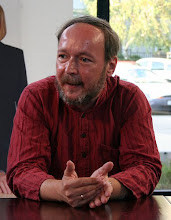
In the evening after the Indian Psychiatric Society meeting there was a Bharatanatyam session. According to Wikipedia "Bharatanatyam traces its origins to the Natya Shastra written by Bharata Muni, a Hindu sage. In ancient times it was performed as dasiattam by temple Devadasis. Many of the ancient sculptures in Hindu temples are based on Bharata Natyam dance postures karanas. In fact, it is the celestial dancers, apsaras, who are depicted in many scriptures dancing the heavenly version of what is known on earth as Bharatanatyam. In the most essential sense, a Hindu deity is a revered royal guest in his temple/abode, to be offered a standard set of religious services called Sodasa Upacharas ("sixteen hospitalities") among which are music and dance, pleasing to the senses. Thus, many Hindu temples traditionally maintained complements of trained musicians and dancers, as did Indian rulers.
Bharata Natyam as a dance form and carnatic music set to it are deeply grounded in Bhakti. Bharata Natyam, it is said, is the embodiment of music in visual form, a ceremony, and an act of devotion. Dance and music are inseparable forms; only with Sangeetam (words or syllables set to raga or melody) can dance be conceptualized.
Essential ideas
Bharatanatyam is considered to be a fire-dance — the mystic manifestation of the metaphysical element of fire in the human body. It is one of the five major styles (one for each element) that include Odissi (element of water), and Mohiniattam (element of air). The movements of an authentic Bharatanatyam dancer resemble the movements of a dancing flame. Contemporary Bharatanatyam is rarely practiced as Natya Yoga, a sacred meditational tradition, except by a few orthodox schools (see Yoga and Dance)."
Bharata Natyam as a dance form and carnatic music set to it are deeply grounded in Bhakti. Bharata Natyam, it is said, is the embodiment of music in visual form, a ceremony, and an act of devotion. Dance and music are inseparable forms; only with Sangeetam (words or syllables set to raga or melody) can dance be conceptualized.
Essential ideas
Bharatanatyam is considered to be a fire-dance — the mystic manifestation of the metaphysical element of fire in the human body. It is one of the five major styles (one for each element) that include Odissi (element of water), and Mohiniattam (element of air). The movements of an authentic Bharatanatyam dancer resemble the movements of a dancing flame. Contemporary Bharatanatyam is rarely practiced as Natya Yoga, a sacred meditational tradition, except by a few orthodox schools (see Yoga and Dance)."

2 comments:
what is the message we are sending to the kids today. Every Guru says their style is the greatest. This is killing the sprit of the children to learn dance. I got a daughter who is very interested in dance. we moved a lot due to my husbands work she is learning from 5 years didn't get past allaripu and jatiswaram. Again we moved and we found 2 people teaching bharatanatyam. Again they say that their style is different. I don't know what to do . They want to start from the step one. any suggessions???
There is only one bharata muni.
I can feel your problem as I have moved around also quite frequently and needed to adopt three different styles. The best thing is to find teachers who teach Kalakshetra style, because that seems to be pretty well standardized. But apart of this your daughter will at some point of time know the alarippu and all the other items and maybe she will also develop the skill to adapt herself quickly to different styles and choreographies.
I wish a lot of joy for her with dancing!
Arpad
Post a Comment